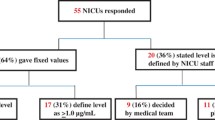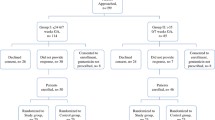Abstract
Gentamicin (GM) is used for neonates as the initial treatment for neonatal bacterial infection. An association between high trough GM levels and the elevation of the serum creatinine (sCr) level and hearing loss has been reported, although there have been no reports investigating the serial changes in the sCr level in preterm neonates treated with GM. The present study evaluated the serial changes in the sCr level and the incidence of hearing loss in preterm neonates treated with GM. This study included 56 neonates born at a gestational age of 32–36 weeks. Fifteen (group 1) and 20 (group 2) neonates were treated with 2.5 mg/kg of GM every 12 h and 4 mg/kg of GM every 36 h, respectively. Group 3 included 21 neonates without GM therapy. Serum GM levels, serial changes in the sCr levels, and the incidence of hearing loss were then compared among the three groups. The serum trough GM level in group 2 was significantly lower than that in group 1 (P < 0.001), whereas the serum peak GM levels in these groups were almost the same. The ratio of the sCr level at birth to that at the 5th day of life in group 1 was the lowest among the 3 groups. No neonates had hearing loss. GM therapy worsened the sCr level in late preterm neonates, especially those with multiple doses per day. The appropriate use of GM is needed in order to prevent the occurrence of nephrotoxicity.


Similar content being viewed by others
References
Schuchat A, Zywicki SS, Dinsmoor MJ, Mercer B, Romaguera J, O'Sullivan MJ et al (2000) Risk factors and opportunities for prevention of early-onset neonatal sepsis: a multicenter case-control study. Pediatrics 105:21–26
Verani JR, McGee L, Schrag SJ, Division of Bacterial Diseases, National Center for Immunization and Respiratory Diseases, Centers for Disease Control and Prevention (CDC) (2010) Prevention of perinatal group B streptococcal disease--revised guidelines from CDC, 2010. MMWR Recomm Rep 59:1–36
Polin RA, Committee on Fetus and Newborn (2012) Management of neonates with suspected or proven early-onset bacterial sepsis. Pediatrics 129:1006–1015
Clifford V, Garland SM, Grimwood K (2012) Prevention of neonatal group B streptococcus disease in the 21st century. J Paediatr Child Health 48:808–815
Caffrey Osvald E, Prentice P (2014) NICE clinical guideline: antibiotics for the prevention and treatment of early-onset neonatal infection. Arch Dis Child Educ Pract Ed 99:98–100
Toda N, Hoshina T, Koga Y, Ochiai M, Kaku N, Yamamura K et al (2016) Analysis of death due to infectious diseases in patients hospitalized in the pediatric ward of a single Japanese tertiary medical facility. Jpn J Infect Dis 69:464–470
Stoll BJ, Hansen NI, Sánchez PJ, Faix RG, Poindexter BB, Van Meurs KP, Eunice Kennedy Shriver National Institute of Child Health and Human Development Neonatal Research Network et al (2011) Early onset neonatal sepsis: the burden of group B Streptococcal and E. coli disease continues. Pediatrics 127:817–826
Begg EJ, Barclay ML (1995) Aminoglycosides--50 years on. Br J Clin Pharmacol 39:597–603
Touw DJ, Westerman EM, Sprij AJ (2009) Therapeutic drug monitoring of aminoglycosides in neonates. Clin Pharmacokinet 48:71–88
Serane TV, Zengeya S, Penford G, Cooke J, Khanna G, McGregor-Colman E (2009) Once daily dose gentamicin in neonates - is our dosing correct? Acta Paediatr 98:1100–1105
Jansen D, Peters E, Heemskerk S et al (2016) Tubular injury biomarkers to detect gentamicin-induced acute kidney injury in the neonatal intensive care unit. Am J Perinatol 33:180–187
Antolik TL, Cunningham KJ, Alabsi S, Reimer RA (2017) Empirical gentamicin dosing based on serum creatinine levels in premature and term neonates. Am J Health Syst Pharm 74:466–472
Murry KR, McKinnon PS, Mitrzyk B, Rybak MJ (1999) Pharmacodynamic characterization of nephrotoxicity associated with once-daily aminoglycoside. Pharmacotherapy 19:1252–1260
El-Chaar GM, Supaswud-Franks T, Venugopalan L, Kohn N, Castro-Alcaraz S (2016) Extended-interval gentamicin administration in neonates: a simplified approach. J Perinatol 36:660–665
Bateman DA, Thomas W, Parravicini E, Polesana E, Locatelli C, Lorenz JM (2015) Serum creatinine concentration in very-low-birth-weight infants from birth to 34-36 wk postmenstrual age. Pediatr Res 77:696–702
Miall LS, Henderson MJ, Turner AJ, Brownlee KG, Brocklebank JT, Newell SJ et al (1999) Plasma creatinine rises dramatically in the first 48 hours of life in preterm infants. Pediatrics 104:e76
Eltahawy AT, Bahnassy AA (1996) Aminoglycoside prescription, therapeutic monitoring and nephrotoxicity at a university hospital in Saudi Arabia. J Chemother 8:278–283
Naeimi M, Maamouri G, Boskabadi H, Golparvar S, Taleh M, Esmaeeli H et al (2009) Assessment of aminoglycoside-induced hearing impairment in hospitalized neonates by TEOAE. Indian J Otolaryngol Head Neck Surg 61:256–261
El-Barbary MN, Ismail RI, Ibrahim AA (2015) Gentamicin extended interval regimen and ototoxicity in neonates. Int J Pediatr Otorhinolaryngol 79:1294–1298
Galankin TL, Kolbin AS, Sidorenko SV, Kurylev AA, Malikova EA, Lobzin YV et al (2018) Retrospective surveillance of antibiotic use in maternity wards and neonatal intensive care units in Saint Petersburg, Russia. Eur J Clin Microbiol Infect Dis 37:1531–1537
Cantey JB, Wozniak PS, Sánchez PJ (2015) Prospective surveillance of antibiotic use in the neonatal intensive care unit: results from the SCOUT study. Pediatr Infect Dis J 34:267–272
Acknowledgments
We appreciate the help of Dr. Brian Quinn (Japan Medical Communication, Fukuoka, Japan) for editing the manuscript.
Author information
Authors and Affiliations
Corresponding author
Ethics declarations
Conflict of interest
The authors declare that they have no conflict of interest.
Ethical approval
Our prospective observational study was approved by the Institutional Review Board of University of Occupational and Environmental Health, Japan.
Informed consent
Informed consent was obtained from all individual participants included in the study.
Additional information
Publisher’s note
Springer Nature remains neutral with regard to jurisdictional claims in published maps and institutional affiliations.
Rights and permissions
About this article
Cite this article
Shimizu, D., Ichikawa, S., Hoshina, T. et al. The evaluation of the appropriate gentamicin use for preterm infants. Eur J Clin Microbiol Infect Dis 38, 2365–2369 (2019). https://doi.org/10.1007/s10096-019-03689-7
Received:
Accepted:
Published:
Issue Date:
DOI: https://doi.org/10.1007/s10096-019-03689-7




